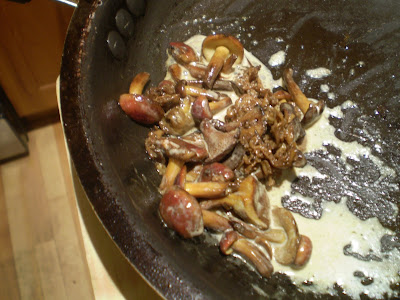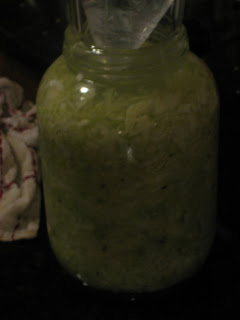I had my first real mushroom hunting success of the season this weekend. In addition to ¾ of a pound of chanterelles, I found about ¼ pound of boletes, a decent-sized coral mushroom and a huge fruiting of pale jelly fungus that I have not yet been able to identify. There were a good number of other, less interesting species also fruiting, and some rather abundantly.
Can you see the chanterelles?
Here they are, ready for cleaning:
They were scattered in two areas about 20 feet apart. As you see, they are fairly small and a kind of buff color. I also found two very small, bright golden chanterelles that were a little ways off. I’m not sure if they were fruiting separately or were a different color for some other reason. I left the smallest mushrooms in the ground on Saturday and came back for them on Sunday. Their 24-hour growth was detectable but not significant. I picked ½ a pound Saturday and the rest Sunday.
I also met a middle-aged Asian couple foraging in the area on Sunday who asked me for some guidance. I told them that the red-capped, yellow-pored boletes that are fruiting in the area are almost certainly edible, and that I had already eaten some with no issues. I also, perhaps foolishly, showed them where the chanterelles were fruiting so that they would know what it looks like. Probably too generous. The woman is holding out for oysters anyway, apparently. The man said that he had been told the coral mushroom I had is edible, which I already suspected was the case. He wasn’t sure about the jelly fungus, but he has heard that the edible “jew’s ear” grows in the area.
Here are the other mushrooms from Sunday (jelly not pictured):
I cooked the boletes I collected on Saturday and ate them with gorgonzola polenta. They are no King Bolete, but still have a nice taste.
The coral mushroom is kind of earthy with a nice, chewy texture. It is also extremely peppery when raw, less so when cooked. I think small raw pieces would be really good in a salad.
I sautéed the second batch of boletes with the coral mushroom and ate them with cream and some pasta.
Monday, June 28, 2010
Tuesday, June 22, 2010
Sauerkraut
I actually made this a couple months ago, but didn't have the pictures on my computer until this week.
Sauerkraut is incredibly simple. In fact, it is just cabbage and salt. For this batch, I threw in some juniper berries and caraway seeds to spice things up.
I used one and a half large heads of green cabbage, which yielded a bit under five useable pounds (I think) after I had removed damaged leaves and cored the heads. By far the most difficult part of the process is shredding the cabbage really fine - this is where a kraut board, which is basically a huge mandoline comes in. Of course, I don't have one, so I just chopped away.
Once the cabbage was shredded, I tossed it with:
3 tablespoons salt,
1 tablespoon whole juniper berries (which I picked in New Mexico)
and 1 tablespoon caraway seeds

Sauerkraut is incredibly simple. In fact, it is just cabbage and salt. For this batch, I threw in some juniper berries and caraway seeds to spice things up.
I used one and a half large heads of green cabbage, which yielded a bit under five useable pounds (I think) after I had removed damaged leaves and cored the heads. By far the most difficult part of the process is shredding the cabbage really fine - this is where a kraut board, which is basically a huge mandoline comes in. Of course, I don't have one, so I just chopped away.
Once the cabbage was shredded, I tossed it with:
3 tablespoons salt,
1 tablespoon whole juniper berries (which I picked in New Mexico)
and 1 tablespoon caraway seeds

Once everything is mixed together, place in a jar or crock of the appropriate size and weight with a plastic bag filled with water, or, as I eventually did, a glass full of water which happened to fit the jar perfectly. The cabbage should release enough water to cover itself in brine, but if it doesn't, add extra brine with 1.5 tablespoons of salt for each quart of water. I found that I had to add brine periodically because water would evaporate off, although I didn't use quite so much salt since I figured the salt was getting left behind anyway.
At 70-75 degrees, the cabbage will take 2-4 weeks to fully ferment and at 60 degrees it will take 5-6 weeks. I let mine ferment for about 3 weeks, then capped the jar and put it in the fridge, where it still is. When it's ready, the cabbage will be completely white, and will no longer be producing bubbles.
I haven't gotten to eat this with a hot dog or sausage yet, but it has been a pretty tasty addition to a few sandwiches. Need to get some sausages though.
Also, the sauerkraut will smell pretty bad while it's fermenting. Be warned. I wasn't.
Friday, June 18, 2010
City Shrooms
All of these mushrooms were harvested within half a mile of my home.
The first bunch of inky caps was growing in the grassy area around a tree on the sidewalk. The picture doesn't quite capture it, but the fatter ones were really quite large.
After cleaning them, I cut them in halves and quarters depending on their size. I then sauteed them in olive oil with coarsely chopped garlic. They released a lot of juice, most of which I poured off. I then added some peeled San Marzano tomatoes, capers and the reserved mushroom liquid. Tasty little sauce.
The first bunch of inky caps was growing in the grassy area around a tree on the sidewalk. The picture doesn't quite capture it, but the fatter ones were really quite large.
After cleaning them, I cut them in halves and quarters depending on their size. I then sauteed them in olive oil with coarsely chopped garlic. They released a lot of juice, most of which I poured off. I then added some peeled San Marzano tomatoes, capers and the reserved mushroom liquid. Tasty little sauce.
The next bunch were also inky caps, but smaller, whiter and a little more firm. The picture below of the last handful shows how dirty they were. They were growing under and around a bush and I harvested them after a rain so it was a bit muddy.
All cleaned up.
Cooked them up with butter, some sliced onion and chopped garlic. When they were pretty well cooked, I added cream and a good amount of gorgonzola, then when everything was melted in, tossed with spaghetti.
Subscribe to:
Posts (Atom)











